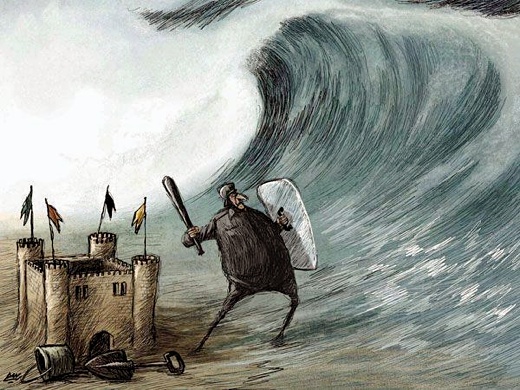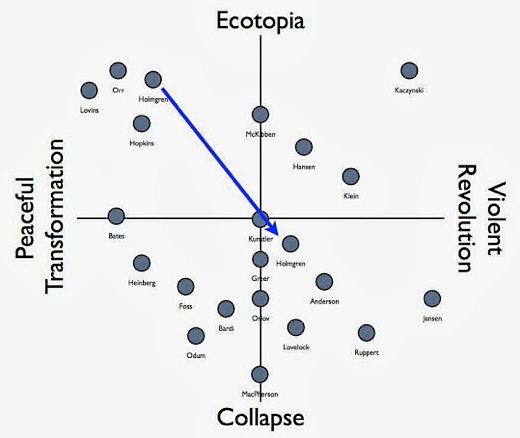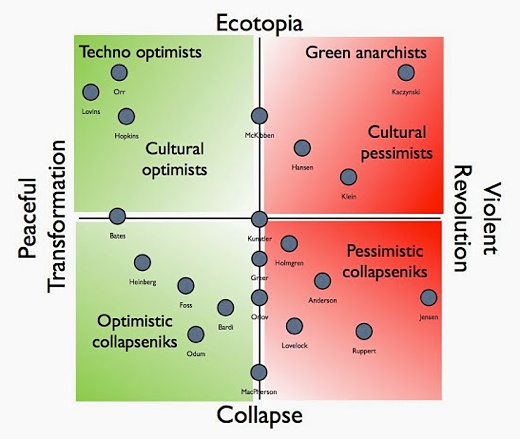SUBHEAD: Some have become “terra-ists” bringing down the system by acts of economic disobedience.
By Albert Bates on 14 January 2014 for The Great Change -
(http://peaksurfer.blogspot.co.uk/2014/01/charting-collapseniks.html)

Image above: Illustration used for article "Collapse? Fast or Slow?". From (http://22billionenergyslaves.blogspot.com/2012/08/collapse-sudden-or-slow.html).
"A ferment in the environmental movement, brewing for many years, has now bubbled up into the blogosphere. We are dipping our ladle in here to take a little taste of it, even though we are quite certain it is not done fermenting.
Rather than spurning financial system terrorists, Holmgren urges activists to become “terra-ists”; to directly bring down the system by thousands of acts of economic disobedience.
Bill McKibben has been stirring the wort of whether social activism can save us for many years. In Eaarth: Making Life on a Tough New Planet, as in The End of Nature a quarter century earlier, he poignantly waffled, in elegant prose, between hope and despair. Since launching 350.org — “the first political action with a number for a name” — he has urged those of us with any remaining shred of hope for our children’s future, given what we now know about climate change, to step up and lay our lives on the line. Get arrested. Risk lengthy jail terms and even death to stop this atrocity. Do not go gentle into that good night.
Words to this effect we have heard much longer and louder from Derrick Jensen, another eloquent writer, the difference being that McKibben advocates for non-violence in the mold of Gandhi and King, while Jensen has no qualms about advocating violence. Naomi Klein, another stirring writer with an arrest record, calls for acts of resistance large and small.
McKibben is tepid about taking on capitalism’s growth imperative, as though it were not a major contributing factor, while neither Holmgren, Klein nor Jensen have any such reservations.
Thus we are tasting many different flavors of leadership, or literary guidance, in the shaping of the nascent climate resistance movement.
Scientists themselves have been growing politically more active and radicalized, as Klein described in her October New Statesman essay. If you go back enough years you’ll find scientists like Dennis Meadows, Howard Odum and James Lovelock, all of whom correctly foresaw the impending collision between consumer civilizations and natural systems. Lovelock made a series of climate-and-society predictions that went unheeded for 20 years but hold up well in retrospect.
Joining the chorus of climate Cassandras with more structured harmonies are the peak-oilers and financial collapsarians. These thoughtful writers straddle a continuum that is both time-sensitive (near-term, middle term, long-term) and outcome ambivalent — they are undecided as to whether the future they foresee will be a good thing, a bad thing, or even survivable.
Guy MacPherson has staked out the lonely position for near-term human extinction, which might be a good thing or a bad thing, depending on how you look at it. Richard Heinberg, Nicole Foss and Steve Keen all see financial constraints as the leading edge of whatever storm is forming, and are not making predictions about how or when, but are planting gardens and putting up canned goods nonetheless.
Michael Ruppert, James Howard Kunstler and Dmitry Orlov are also decoupling from whatever economic grids they may be attached to, but do not foresee a particularly happy outcome in all this. Social unraveling is not a pretty picture, as Orlov describes in his Five Stages of Collapse.
Still clinging to the possibility of some salvageable human prospect are cultural and technical optimists like Amory Lovins, David Orr and Rob Hopkins. We personally would also favor this idea of an ecotopian future, and have been working to bring it about it for half a century now, but our own position is that collapse is likely unstoppable now, given, as Nicole Foss puts it “the excess claims on underlying real wealth.”
What suddenly bubbled up from the blog vat at the start of 2014 was a white paper authored by David Holmgren, one of the founders of permaculture, reversing a position he had long espoused.
Instead of associating himself with peaceful change by calling for restraint on overconsumption and gradual adoption of the degrowth economic paradigm, extending it ever outward until it became the mainstream culture, Holmgren abruptly called for “Crash on Demand” or a strategic decoupling by masses of youth (and elders) from the economic system that is the crashing the planet’s ecological stasis, by simply walking away.
“Rather than spurning financial system terrorists [a.k.a. banksters or the 1/10th-percent],” Holmgren urged activists to become “terra-ists”; to directly bring down the system by thousands of acts of economic disobedience. “The urgency for more radical action to build parallel systems and disconnect from the increasingly centralized destructive mainstream is a logical and ethical necessity whether or not it contributes to a financial collapse,” he wrote provocatively.
This immediately inspired a flurry of thoughtful responses, as might be expected. One of the most impassioned came from one whose positions Holmgren had just abandoned. Writing for Transition Culture January 13, Rob Hopkins responded, “to state that we need to deliberately, and explicitly, crash the global economy feels to me naive and dangerous, especially as nothing in between growth and collapse is explored at all.”
Hopkins main truck with Holmgren is his readiness to toss away all notions of mainstreaming permaculture and transition towns. “I may be naive,” he writes, “but I still think it is possible to mobilise that in a way that, as the Bristol Pound illustrates, gets the support and buy-in of the 'City/State' level, and begins to really put pressure and influence on 'National' thinking. I may be naive, but it's preferable to economic collapse in my book, and I think we can still do it.”
Concerned that a hard line position would expose social change agents to the full weight of state security as well as to the blame cascading from an angry populace, and that sewing the seeds of civil discord is always dangerous, Nicole Foss wrote on The Automatic Earth January 9 that financial collapse is already well underway and there is no need to expedite the process.
“While I understand why Holmgren would open a discussion on this front, given what is at stake, it is indeed dangerous to ‘grasp the third rail’ in this way. This approach has some aspects in common with Deep Green Resistance, which also advocates bringing down the existing system, although in their case in a more overtly destructive manner.”
“Decentralization initiatives already face opposition, but this could become significantly worse if perceived to be even more of a direct threat to the establishment,” Foss concluded.
Having these positions staked out was useful for the discussion of strategy that change agents need to be more engaged with. Klein and McKibben seem to think that if we just have enough “Battles for Seattle,” the economic system of global civilization will be radically restructured. Our own experience in joining dozens of massive marches and actions of civil disobedience but nonetheless failing to end the Vietnam War has perhaps jaundiced our views in this regard. Moreover, Holmgren and Foss make clear that that’s not going to happen.
Even the recently unveiled strategy of fossil fuel divestment, as promising as it is, and as grounded in investment reality of the stranded, overvalued assets unable to ever be burnt, stands little chance of being able to arrest climate tipping points that may have been triggered decades ago.
Foss is not especially concerned for the climate, apparently clinging to the position Holmgren had some years ago, that collapse of energy and economics will augur in a low-carbon future, although she does acknowledge the lurking unknowns from reversed global dimming.
“We need to get down to the business of doing the things on the ground that matter, and to look after our own local reality. We can expect considerable opposition from those who have long benefited from the status quo, but if enough people are involved, change can become unstoppable.
It won’t solve our problems in the sense of allowing us to continue any kind of business as usual scenario, and it won’t prevent us from having to address the consequences of overshoot, but a goal to move us through the coming bottleneck with a minimum amount of suffering is worth striving for.”
Our own view is that the likelihood that a runaway greenhouse effect is now underway is greater than it has ever been, and to call what is coming a bottleneck is a poor choice of words except perhaps in the sense of the genetic bottleneck experienced 70-80 thousand years ago in connection with a supervolcano that reduced our hereditary lines to fewer than 5000 individuals worldwide.
While we understand the concern she raises about unduly politicizing the issue, we’d say that cat has left its bag and keeping silent for fear of numbing the population makes no more sense for climate change than it does for Ponzi economics.
Indeed, the parallels between the overdraft on Earth’s atmosphere and the excess claims on fictional central bank assets are striking — neither is going to go away simply by ignoring them. In both cases, the cake already baked.
This prompts us to make a new grid to categorize the range of opinions amongst peakists, collapseniks, politicos and anarchists. It goes something like this, at first drawing, and we welcome corrections, especially from those named.
Holmgren’s change of position can be charted this way:

Image above: Chart demonstrating Holmgren's vector of change. From original article. This is revision #6 since the original post.
If we plot the respective positions of other change strategists, they look something like this:

Image above: Chart illustrating several "collapsniks" positions. From original article. This is revision #6 since the original post.
Our own position in this matrix outlined in two books since 2006,
Not surprising, given what they know, scientists like Lovelock, Ken Anderson, and Howard Odum all fall below the line dividing Ecotopia from Collapse. Odum, we suspect, would have been in favor of peaceful transformation, while the others would like us to push harder and force the issue.
Naturally those most concerned with Holmgren’s shift would be those closest to his former position, including Rob Hopkins. Those closest to him now — Kunstler, Anderson, Hansen and Klein — would be the most likely to approve.
What is missing from Holmgren’s paper are the advances in terrestrial carbon sequestration — as opposed to Ponzi geoengineering — in no small measure reaching fruition by dint of permaculture design.
While permaculturists like Rob Hopkins, Declan Kennedy and Max Lindegger pursued innovations in social structures — transition towns, complimentary currencies and ecovillages — other permaculturists — Darren Doherty, Richard Perkins, Joel Salatin and Ethan Roland, to name just some — have pushed the envelope to see how much carbon can actually be returned to the soil. This revolution is the subject of Courtney White’s new book, Grass, Soil, Hope: A Journey Through Carbon Country, scheduled for release in June.
Would we have ever learned that a mere 2% increase in the carbon content of the planet’s soils could offset 100% of all greenhouse gas emissions going into the atmosphere if we had not been so frightened of climate change by Al Gore and other scaremongers? Speaking as one who wandered deep into Amazonian history to discover this new paradigm, we reply: probably not.
We’ve added some color coding and sector analysis with this third iteration:

Image above: Chart with color coding for pacifism vs violence. From original article. This is revision #6 since the original post.
Now lets step back and add a whole ‘nother layer to this. There is a really good cultural transformation going on, with ecovillagers, ecological restorationists, soil remineralizers and post-empire econometricists.
Simultaneously, there is a really negative übertrend of banksters and purchased or annointed politicians enriching themselves off oil, nuke and the wealth of nature, then turning all that surplus into the worst kinds of pollution – the kinds that take millennia to degrade and even then impair gene pools for untold generations.
These two conflicting transformations coexist against the backdrop of almost immeasurably immense climatic and biosystemic change that will severely affect, if not drive, our world in the future. We all exist in the context of ecosystems and yet these familiar norms are being utterly destroyed while we write this.
The tiny little good ecovillagers, permaculturists and transition towners do pales in comparison to the scale of damage of unrestrained growthaholism that seems almost a genetic imperative of our species — and we are the keystone species in ecosystem Earth.
Holmgren has this right, and it is undeniably frightening. We’re sure there may be more thoughtful readers who can add to this analysis and produce more insights than we have, but as we say, we’re just grateful to be having this kind of discussion.
• After co-teaching a permaculture course in Belize with Nicole Foss next month, we will be vetting this analysis with Dmitry Orlov, Dennis Meadows, John Michael Greer, Gail Tverberg, KMO and others at the Age of Limits conference in Pennsylvania in May. .
No comments :
Post a Comment